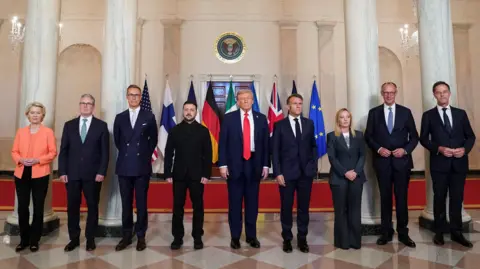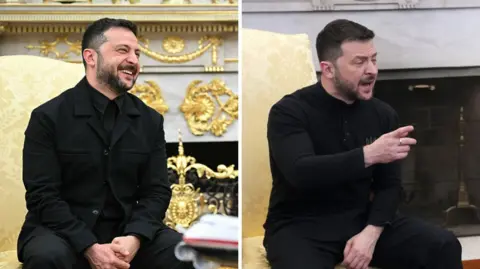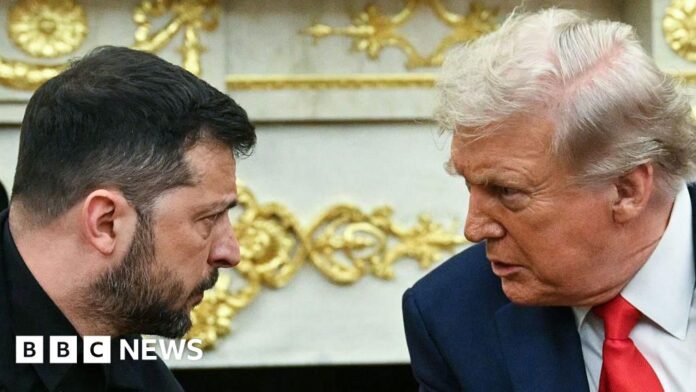Reporting from the White House
President Volodymyr Zelensky returned to the White House on Monday to meet US President Donald Trump for fresh talks aimed at ending the war in Ukraine.
Several European leaders also rejigged plans so they could fly to Washington to attend the meeting, days after Trump met Russia’s President Vladimir Putin in Alaska for a summit that failed to result in a ceasefire.
Despite optimistic words by Trump and some more lukewarm assessments from his European partners, by Monday evening there were no tangible commitments to security guarantees or concrete steps towards a peace deal.
Here are the key takeaways from the talks.
A Putin-Zelensky meeting on the cards?
One of Trump’s much-touted objectives is to organise a three-way meeting with Zelensky and Putin.
Before his talks with European leaders on Monday, he said it was now a matter of “when, not if” such a meeting would take place.
Following the summit, Trump said he had called Putin to begin “arranging” bilateral talks between the Russian leader and Zelensky.
Trump said that following a bilateral between Putin and Zelensky, at a location to be determined, there would be a trilateral where the US president would join the two.
A Putin adviser said afterwards that Trump and Putin had spoken for 40 minutes on the phone on Monday.
Before European leaders sat down with Trump in the East Room at the White House, a hot mic picked up remarks between the US leader and French President Emmanuel Macron.
“I think he wants to make a deal. I think he wants to make a deal for me. You understand that? As crazy as that sounds,” Trump told Macron, appearing to refer to Putin.
It remains to be seen how straightforward it will be to bring two such bitter enemies face-to-face at the negotiating table for the first time since Russia’s full-scale invasion began in February 2022.
For months, Zelensky has been pushing to meet Putin, although there is no indication the Ukrainian leader thought such a bilateral could bring the conflict closer to an end.
Instead, this was likely a way of proving his argument that Russia is not serious about pursuing peace, as he reckoned that Putin had no interest in agreeing to a meeting of this sort.
The Russian president has previously said he regards Zelensky as “illegitimate” because no elections have been held in Ukraine since the start of the war amid martial law.
The Kremlin has repeatedly turned down the idea of a Putin-Zelensky bilateral.
Two weeks ago Moscow argued that the Russian and Ukrainian presidents had no reason to meet until “after the appropriate distance” between the positions of the two countries was “overcome”.
In a noncommittal statement shared by Kremlin aide Yuri Ushakov on Monday night, Moscow said it deemed it “worthwhile” to “explore the possibility of raising the level of representatives” from the Russian and Ukrainian delegations taking part in negotiations.
It’s worth noting that the Kremlin’s language is far vaguer than Trump’s, and includes no suggestion that Putin himself may be preparing to attend a bilateral meeting with Zelensky – as much as Trump seems intent on bringing them together.
Even if such a meeting came about, there is also the question of what it might achieve when the Russian and Ukrainian demands for ending the war remain so far apart.
Europeans push back as Trump backs away from ceasefire
In his remarks alongside the European leaders on Monday, Trump seemed to dismiss the need for any ceasefire before negotiations to end the war can take place.
In the past, that has been a key demand of Ukraine, which made clear it sees an end to the fighting as a prerequisite for further talks with Russia and, ultimately, for a longer-term settlement.
A ceasefire could also be marginally easier to agree than a full peace deal, which would take many months of negotiations, during which Russia’s assault on Ukraine would probably continue.
On Monday, Trump noted that the six wars he claims to have helped stop since January – including conflicts between Rwanda and the Democratic Republic of Congo, Thailand-Cambodia and India-Pakistan – ended without any formal ceasefire in place first.
“I don’t know that it’s necessary,” he said.
The European leaders appeared to push back on this suggestion, with the strongest rebuttal coming from German Chancellor Friedrich Merz.
“I can’t imagine that the next meeting would take place without a ceasefire,” Merz said. “So, let’s work on that and let’s try to put pressure on Russia.”
As things stand, it remains unclear whether the government in Kyiv is as steadfast in its belief that a ceasefire is a necessary step towards meaningful talks with Moscow.
When asked to speak, Zelensky did not reiterate his previous calls for a ceasefire to be put in place.
Trump hints at security guarantees
One of the questions put to Zelensky was about what he would need from the US to guarantee his country’s security. Was it troops, intelligence, equipment?
In a moment that conveyed the sense of urgency he seemingly tried to suppress throughout much of the press conference, Zelensky leaned forward in his chair and said, emphatically: “Everything.”
“We need a strong Ukrainian army,” he added. “It’s about weapons, people, training missions and intelligence.”
Trump did not offer US military boots on the ground.
But when he was asked by reporters whether US security guarantees for Ukraine could include any American military in the country, Trump did not rule it out.
He said Europe was the “first line of defence”, but that “we’ll be involved.”
“We’ll give them good protection,” the president said at one point.
This is the most decisive Trump has ever sounded on the issue of security guarantees, which are generally seen as paramount to any sort of deal with Russia.
On Monday, the US president said that during last week’s Alaska summit Putin had accepted that there would be security guarantees for Ukraine as part of any peace deal.
But the lack of detail on what exactly these guarantees might consist of is concerning to both Kyiv and Europe, and behind closed doors leaders will no doubt try to impress on Trump that the US deterrent needs to be more than just symbolic.
A continued flow of weapons to Ukraine would be welcome; a promise of American boots on the ground would be even more consequential.
Such a level of commitment may be difficult to obtain, at this stage, from Trump.
Deploying US troops on Ukrainian soil would mean running the risk of direct confrontation with Russia.
It would also constitute a major direct intervention by a president who has prided himself on his ability to disentangle the US from foreign conflicts.
 Reuters
ReutersZelensky launches charm offensive
Given his acrimonious last visit to the Oval Office in February, the Ukrainian president went to considerable lengths to be congenial and charm his American hosts – including a flurry of six “thank yous” within the first few minutes of the meeting.
The last time he was at the White House, Zelensky was scolded by Vice-President JD Vance for a perceived lack of gratitude for US support for Ukraine during the war.
Another point of contention in February’s meeting – Zelensky’s attire – also came up.
This time, Zelensky was dressed in a dark suit rather than his traditional military garb, and appeared well prepared with a joke when asked about his outfit by the same reporter who had previously criticised him for not wearing a suit to the Oval Office last time.
After the reporter told him that he looked “fabulous”, Zelensky shot back that the journalist was wearing the “same suit” as last time, eliciting laughter from the reporters, Trump and other officials in the room.
“As you see, I changed,” he added.
 Getty Images
Getty ImagesZelensky also sought to forge a family connection during the meeting, handing his host a letter from Ukrainian First Lady Olena Zelenska to be delivered to US First Lady Melania Trump.
“It’s not to you – [it’s] to your wife,” he told Trump.
Other European leaders similarly decided to dial up the flattery with Trump ahead of their multilateral meeting, heaping praise on him for his work in bringing them around the table.
“I really want to thank you for your leadership,” said Nato chief Mark Rutte.
Italian PM Giorgia Meloni said that while there had previously been no sign that Russia wanted to move towards peace “something had changed” thanks to Trump.
Despite the warm tones, the Europeans made a concerted effort to convey that they, too, feel exposed to any future Russian aggression.
French President Emmanuel Macron told fellow leaders somberly: “When we talk about security guarantees, we’re also talking about the matter of the security of the European continent.”



